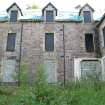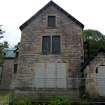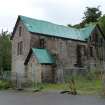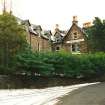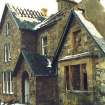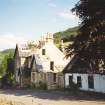Buildings at Risk Register Paused
Following the review of the Buildings at Risk Register the decision has been taken to pause the BARR in order to consider long-term options for its future.
The existing BARR website will remain accessible as a resource, however it will not be updated and we're not accepting nominations for additions to the Register.
Downtime
Please be advised that this website will undergo scheduled maintenance on the following dates:
Sunday 23rd November 18:00 to Monday 24 November 09:00
Stromeferry Hotel, Stromeferry
Ordnance Survey licence number AC0000807262. All rights reserved. © Copyright and database right 2025. Public Sector Viewing Terms
Useful Links
- NRHE:
- STROMEFERRY HOTEL
General Details and Location
Category
AT RISK
Name of Building
Stromeferry Hotel
Other Name(s)
Station Hotel (Former)
Address
Stromeferry
Locality
Postcode
Planning Authority
Divisional Area
Reference No
1488
Listing Category
Unlisted
OS Grid Ref
NG 8638 3467
Location Type
Rural Settlement
HS Reference No
Description
3 storey gabled villa with a dormered range adjoining at right angles. The hotel dates to c.1874, with stables, laundry and offices added in 1882. The front elevation features tripartite windows and a gabled porch. A single storey corrugated-iron range to the right was once the public bar. Stable block and garden adjoin.
The original small settlement expanded rapidly when the Dingwall and Skye Line of the Highland Railway was built in 1870 with its terminus at Stromeferry. The improved services were also used to transport mail, fish and cattle and the railway company decided to run Sunday trains. This offended members of the local population who were opposed to working on the Sabbath and the situation resulted in the Strome Ferry Riot of 1883. In 1897, the railway line was extended from Stromeferry to Kyle of Lochalsh. Much of the traffic transferred to Kyle and Stromeferry declined in importance. However, the ferry across the narrows continued until 1970 when a new road round the head of Loch Carron was completed. (Am Baile)
The hotel features in Iain Banks' novel Complicity as the rundown hotel where a murder takes place.
The original small settlement expanded rapidly when the Dingwall and Skye Line of the Highland Railway was built in 1870 with its terminus at Stromeferry. The improved services were also used to transport mail, fish and cattle and the railway company decided to run Sunday trains. This offended members of the local population who were opposed to working on the Sabbath and the situation resulted in the Strome Ferry Riot of 1883. In 1897, the railway line was extended from Stromeferry to Kyle of Lochalsh. Much of the traffic transferred to Kyle and Stromeferry declined in importance. However, the ferry across the narrows continued until 1970 when a new road round the head of Loch Carron was completed. (Am Baile)
The hotel features in Iain Banks' novel Complicity as the rundown hotel where a murder takes place.
Building Dates
circa 1874 with additions 1882
Architects
Alexander Ross
Category of Risk and Development History
Condition
Very Poor
Category of Risk
High
Exemptions to State of Risk
Field Visits
January 1995, 14/09/2010, 17/6/2013
Development History
June 1992: The hotel is broken into and all internal fixtures stolen or damaged. July 1993: The hotel is ravaged by fire. Highland Council undertakes works to make the building safe and to fence it off. The stables and former 2 storey west wing are destroyed, whilst the remainder of the hotel is left badly damaged. August 1993: Further fire damage is suffered. January 1995: External inspection reveals the hotel to be vacant and roofless. 10 December 1999: The West Highland Free Press reports that Highland and Islands Leisure is seeking Planning Permission to restore the hotel and build 24 houses adjacent. The company is to meet with the Achmore and Stromeferry Community Council. January 2000: Local planners report that applications have been lodged. The scheme includes informal proposals to restore the hotel. February 2000: Agents for the owners report that further damage and theft has occurred. Timber floors have been removed from the eastern part, along with bathroom fittings, services, staircases, skirtings, architraves, doors, partitions and plasterwork. May 2001: Consents are granted to rebuild and extend the hotel, with 16 new-build houses and 15 holiday homes in the grounds. Following the granting of permissions, the site is purchased by Highland and Islands Leisure. August 2004: Construction works commence. March 2005: Agents for the owners report that the remaining wings have recently undergone repairs and are now wind and watertight. Full restoration is awaited. October 2006: LPA indicates that more work is required to make the building both wind and water tight.
May 2010: Local planners report planning permission was granted (in outline) for restoration /reconfiguration of the hotel building as part of a wider development in the village. No detailed plans have been submitted to-date and no developer has come forward to take the project on. The building is in an weather-tight state and generally secure, however no progress has been made on repairing its fabric or structure. All beams and joists were removed by vandals a few years ago.
August 2010: External inspection finds the western parts of the building have been demolished. A temporary rood has been installed, but it is damaged in a number of places. The windows and doors have been blocked up. The rainwater goods have been lost. There are plants growing at the chimney stacks and downpipes.
17 June 2013: External inspection finds the temporary roof coverings are now damaged and several window boardings have been removed, leaving the building exposed to the weather. The site may have been sold to a new owner.
27 March 2014: Notification of intention to demolish has been lodged with Highland Council ref: 14/00467/PNO. Risk level moved to High.
20 June 2016: A member of the public notes further protective boarding to windows has been lost from the former hotel. The application to demolish the structure was withdrawn Mar 2014 ref: 14/00467/PNO.
22 February 2024: Desk-based assessment suggests the building remains At-Risk.
Availability
Current Availability
Unknown
Appointed Agents
Price
Occupancy
Vacant
Occupancy Type
N/A
Present/Former Uses
Building Uses Information: <br />
Present Use 1: N/A Former Use 1: Hotel/Hostel<br />
Present Use 2: N/A Former Use 2: N/A
Name of Owners
Unverified see FAQ on ascertaining ownership
Type of Ownership
Unknown
Information Services
Additional Contacts/Information Source
http://www.ambaile.org.uk/en/item/item_photograph.jsp?item_id=38451
Bibliography
Online Resources
Highland Council HER: <a href="http://her.highland.gov.uk/SingleResult.aspx?uid=MHG25523">http://her.highland.gov.uk/SingleResult.aspx?uid=MHG25523</a><br />
<br />
Dictionary of Scottish Architects: <a href='http://www.scottisharchitects.org.uk/building_full.php?id=215661'>http://www.scottisharchitects.org.uk/building_full.php?id=215661</a>
Classification
Hotels and Inns
Original Entry Date
15-APR-96
Date of Last Edit
23/01/2020



